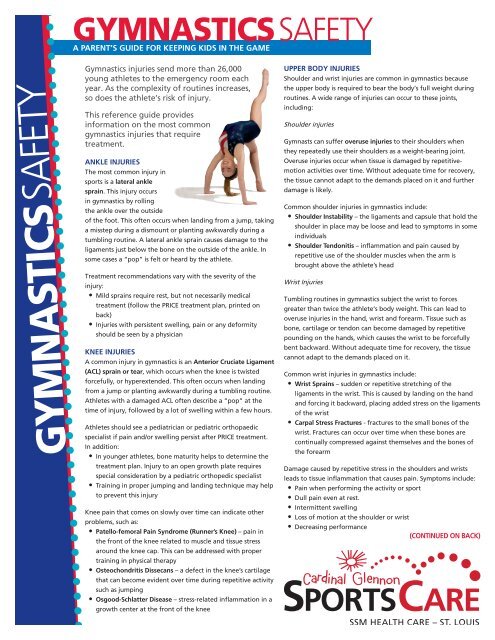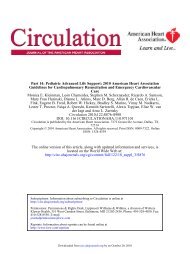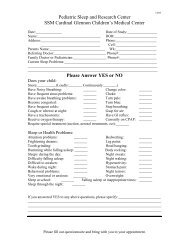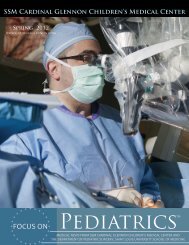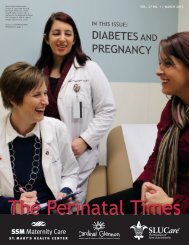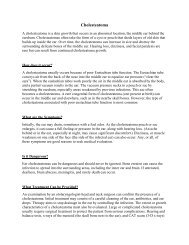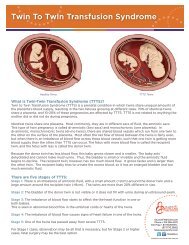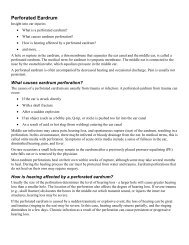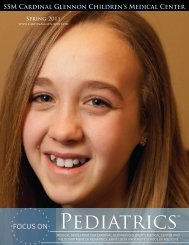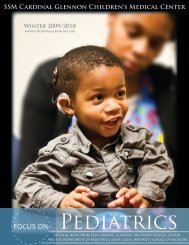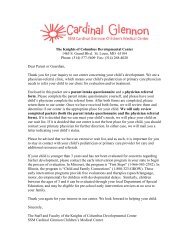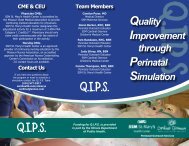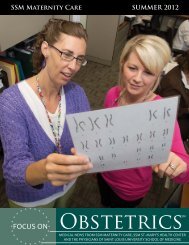Gymnastics - SSM Cardinal Glennon Children's Medical Center
Gymnastics - SSM Cardinal Glennon Children's Medical Center
Gymnastics - SSM Cardinal Glennon Children's Medical Center
Create successful ePaper yourself
Turn your PDF publications into a flip-book with our unique Google optimized e-Paper software.
GYMNASTICS SAFETY<br />
A PARENT’S GUIDE FOR KEEPING KIDS IN THE GAME<br />
GYMNASTICS SAFETY<br />
<strong>Gymnastics</strong> injuries send more than 26,000<br />
young athletes to the emergency room each<br />
year. As the complexity of routines increases,<br />
so does the athlete’s risk of injury.<br />
This reference guide provides<br />
information on the most common<br />
gymnastics injuries that require<br />
treatment.<br />
ANKLE INJURIES<br />
The most common injury in<br />
sports is a lateral ankle<br />
sprain. This injury occurs<br />
in gymnastics by rolling<br />
the ankle over the outside<br />
of the foot. This often occurs when landing from a jump, taking<br />
a misstep during a dismount or planting awkwardly during a<br />
tumbling routine. A lateral ankle sprain causes damage to the<br />
ligaments just below the bone on the outside of the ankle. In<br />
some cases a “pop” is felt or heard by the athlete.<br />
Treatment recommendations vary with the severity of the<br />
injury:<br />
• Mild sprains require rest, but not necessarily medical<br />
treatment (follow the PRICE treatment plan, printed on<br />
back)<br />
• Injuries with persistent swelling, pain or any deformity<br />
should be seen by a physician<br />
KNEE INJURIES<br />
A common injury in gymnastics is an Anterior Cruciate Ligament<br />
(ACL) sprain or tear, which occurs when the knee is twisted<br />
forcefully, or hyperextended. This often occurs when landing<br />
from a jump or planting awkwardly during a tumbling routine.<br />
Athletes with a damaged ACL often describe a “pop” at the<br />
time of injury, followed by a lot of swelling within a few hours.<br />
Athletes should see a pediatrician or pediatric orthopaedic<br />
specialist if pain and/or swelling persist after PRICE treatment.<br />
In addition:<br />
• In younger athletes, bone maturity helps to determine the<br />
treatment plan. Injury to an open growth plate requires<br />
special consideration by a pediatric orthopedic specialist<br />
• Training in proper jumping and landing technique may help<br />
to prevent this injury<br />
Knee pain that comes on slowly over time can indicate other<br />
problems, such as:<br />
• Patello-femoral Pain Syndrome (Runner’s Knee) – pain in<br />
the front of the knee related to muscle and tissue stress<br />
around the knee cap. This can be addressed with proper<br />
training in physical therapy<br />
• Osteochondritis Dissecans – a defect in the knee’s cartilage<br />
that can become evident over time during repetitive activity<br />
such as jumping<br />
• Osgood-Schlatter Disease – stress-related inflammation in a<br />
growth center at the front of the knee<br />
UPPER BODY INJURIES<br />
Shoulder and wrist injuries are common in gymnastics because<br />
the upper body is required to bear the body’s full weight during<br />
routines. A wide range of injuries can occur to these joints,<br />
including:<br />
Shoulder injuries<br />
Gymnasts can suffer overuse injuries to their shoulders when<br />
they repeatedly use their shoulders as a weight-bearing joint.<br />
Overuse injuries occur when tissue is damaged by repetitivemotion<br />
activities over time. Without adequate time for recovery,<br />
the tissue cannot adapt to the demands placed on it and further<br />
damage is likely.<br />
Common shoulder injuries in gymnastics include:<br />
• Shoulder Instability – the ligaments and capsule that hold the<br />
shoulder in place may be loose and lead to symptoms in some<br />
individuals<br />
• Shoulder Tendonitis – inflammation and pain caused by<br />
repetitive use of the shoulder muscles when the arm is<br />
brought above the athlete’s head<br />
Wrist Injuries<br />
Tumbling routines in gymnastics subject the wrist to forces<br />
greater than twice the athlete’s body weight. This can lead to<br />
overuse injuries in the hand, wrist and forearm. Tissue such as<br />
bone, cartilage or tendon can become damaged by repetitive<br />
pounding on the hands, which causes the wrist to be forcefully<br />
bent backward. Without adequate time for recovery, the tissue<br />
cannot adapt to the demands placed on it.<br />
Common wrist injuries in gymnastics include:<br />
• Wrist Sprains – sudden or repetitive stretching of the<br />
ligaments in the wrist. This is caused by landing on the hand<br />
and forcing it backward, placing added stress on the ligaments<br />
of the wrist<br />
• Carpal Stress Fractures - fractures to the small bones of the<br />
wrist. Fractures can occur over time when these bones are<br />
continually compressed against themselves and the bones of<br />
the forearm<br />
Damage caused by repetitive stress in the shoulders and wrists<br />
leads to tissue inflammation that causes pain. Symptoms include:<br />
• Pain when performing the activity or sport<br />
• Dull pain even at rest.<br />
• Intermittent swelling<br />
• Loss of motion at the shoulder or wrist<br />
• Decreasing performance<br />
(CONTINUED ON BACK)
GYMNASTICS SAFETY (CONT.)<br />
If symptoms persist, athletes should see their pediatrician or<br />
a pediatric orthopedic specialist. In each consecutive season,<br />
repetitive maneuvers by certain body parts can lead to fatigue<br />
and long-term damage.<br />
Gymnasts who desire to lose weight should not lose more than<br />
1-2 pounds a week to avoid break down of lean body mass. Once<br />
a gymnast achieves a healthy body weight, weight maintenance<br />
should be emphasized.<br />
BACK PAIN<br />
<strong>Gymnastics</strong> puts a lot of demand on a young athlete’s back<br />
due to repetitive maneuvers that require hyperextension of<br />
the back (such as back walkovers or back bends). Some injuries<br />
to the back occur suddenly, and are commonly known as a<br />
back strain. Others occur more gradually, especially if the body<br />
doesn’t have time to recover properly.<br />
Over time, repeated hyperextension of the low back can cause:<br />
• Spondylolysis – a stress fracture of the bones in the lower<br />
spine, or lumbar vertebrae<br />
• Spondylolisthesis – the lumbar vertebrae slip forward, if an<br />
athlete with a stress fracture continues to participate in the<br />
sport. This is much more serious, and can lead to continued<br />
pain that may require treatment<br />
Therefore, it is important that gymnasts experiencing low<br />
back pain be restricted from activity until evaluated by their<br />
pediatrician or a pediatric orthopedic specialist.<br />
WEIGHT MANAGEMENT<br />
Gymnasts should aim to stay close to their competition weight<br />
in the off-season in order to avoid dangerous weight-cutting<br />
practices during the competitive season. Weight-loss practices<br />
such as dehydration by excessive sweating, or drinking nothing<br />
or very little, spitting, using laxatives and diuretics and fasting/<br />
starvation are dangerous and can lead to severe health<br />
problems. Dehydration prior to competitions also decreases<br />
strength and performance.<br />
SPORTSCARE AT <strong>SSM</strong> CARDINAL GLENNON<br />
<strong>Cardinal</strong> <strong>Glennon</strong> SportsCare is the premier pediatric sports<br />
medicine provider in St. Louis and St. Charles. We provide<br />
exclusive, direct access to comprehensive medical care for<br />
young athletes.<br />
By working with multiple specialists and care partners, we<br />
guarantee your child will get the top care that is best suited to<br />
treat their unique injury, improving recovery time and outcome.<br />
Many of our services are offered in multiple locations so your<br />
child can even be treated close to home.<br />
Weight loss is best achieved using a combination of reducing<br />
caloric intake and increasing calories burned. Nutrition tips for<br />
good weight control include:<br />
• Give your body energy from sources of carbohydrates, proteins<br />
and fats. Do not omit any food groups<br />
• Choose whole-grain foods, lean protein and healthy fats at<br />
meal times<br />
• Eat a balanced diet rich in fruits, vegetables and fiber<br />
• Drink calorie-free beverages; eat fresh fruits instead of<br />
drinking fruit juices<br />
• Watch your portion sizes<br />
• Choose low-fat dairy products<br />
• Don’t skip meals, but if hungry eat a healthy snack<br />
• Limit high-calorie foods with added sugar and fat – read food<br />
labels to compare calories and look for reduced-sugar and<br />
reduced-fat varieties of your favorite food products<br />
BUMPS, BRUISES, TWISTS & MUSCLE STRAINS<br />
These can affect all areas of the body. Recommended treatment is<br />
the PRICE formula:<br />
Protect the area with a sling or crutches, if necessary<br />
Rest the injured area<br />
Ice the injury for 20 minutes at a time. Do not apply the ice<br />
directly to the skin<br />
Compress the injured area with a wrap. Do not pull tightly, as<br />
this can cut off circulation<br />
Elevate the injured area above the heart, if possible<br />
Partners your child has access to through SportsCare<br />
include <strong>SSM</strong> <strong>Cardinal</strong> <strong>Glennon</strong> Children’s <strong>Medical</strong> <strong>Center</strong>,<br />
<strong>SSM</strong> Orthopedics, <strong>SSM</strong> Physical Therapy and SLUCare, the<br />
physicians of Saint Louis University.<br />
We also keep kids in the game through educational programs<br />
and support for parents, coaches and athletes that focus<br />
on injury prevention, proper technique and overall athletic<br />
health. SportsCare is a young athlete’s best connection to<br />
sports medicine and athletic well-being.<br />
GYMNASTICS SAFETY<br />
Specialists your child has access to through SportsCare include<br />
orthopedists, pulmonologists, cardiologists, radiologists,<br />
neurologists, emergency medicine physicians, adolescent<br />
medicine physicians, rehabilitation specialists, physical<br />
therapists, nutritionists and pediatric psychologists.<br />
For more information about <strong>Cardinal</strong> <strong>Glennon</strong> SportsCare or<br />
to find a specialist for your athlete, call us at 314-577-5640<br />
or visit us at cardinalglennon.com/sportscare.<br />
Web<br />
cardinalglennon.com/sportscare<br />
youtube.com/ssmcardinalglennon<br />
facebook.com/cardinalglennon<br />
twitter.com/cardinalglennon<br />
Expert care for your<br />
young athlete by <strong>SSM</strong><br />
<strong>Cardinal</strong> <strong>Glennon</strong><br />
pediatricians and <strong>SSM</strong><br />
emergency medicine<br />
specialists, 24 hours a<br />
day in the ER at:<br />
DePaul Health <strong>Center</strong><br />
St. Clare Health <strong>Center</strong><br />
St. Joseph Health <strong>Center</strong><br />
St. Joseph Hospital West


